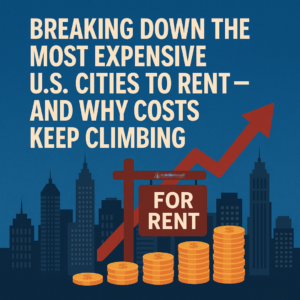For millions of renters across the United States, finding affordable housing has become one of the biggest challenges of 2025. As demand continues to outpace supply, rental costs have surged, particularly in some of the nation’s most desirable — and expensive — cities. A recent FOX8 report sheds light on where renters are paying the most and why these markets have become so costly.
Source: The Most Expensive Places to Rent an Apartment – FOX8
The Top Cities Where Renters Pay the Price
According to recent data, several metro areas consistently top the list of the most expensive rental markets in the U.S.:
San Jose-Sunnyvale-Santa Clara, CA
-
Average Rent: Over $3,300/month
-
The heart of Silicon Valley, San Jose commands some of the highest rents in the country. The booming tech sector continues to drive demand, with limited housing inventory pushing prices up even further.
San Francisco-Oakland-Fremont, CA
-
Average Rent: Over $3,200/month
-
Despite some population shifts during the pandemic, San Francisco remains a powerhouse for tech, finance, and innovation. Strict zoning laws and limited buildable land have kept supply low even as demand remains strong.
New York-Newark-Jersey City, NY-NJ-PA
-
Average Rent: Around $3,000/month
-
The New York metro area has always been synonymous with high living costs. A combination of global appeal, dense population, and limited housing stock make affordable rentals harder to find.
Boston-Cambridge-Newton, MA
-
Average Rent: $2,900–$3,000/month
-
Boston’s renowned universities, booming biotech sector, and strong job market continue to attract high-income residents, keeping rent prices elevated.
Los Angeles-Long Beach-Anaheim, CA
-
Average Rent: $2,800–$3,000/month
-
Southern California’s weather, entertainment industry, and coastal lifestyle keep demand high, even as many renters struggle to keep pace with rising costs.
Why Are Rents So High in These Areas?
Several core factors are driving these skyrocketing rental prices:
Limited Housing Supply
Zoning regulations, environmental restrictions, and community opposition to new developments have significantly slowed the construction of new housing units in many of these cities. With fewer new apartments available, existing inventory becomes increasingly expensive.
Booming Job Markets
Cities like San Francisco, San Jose, Boston, and New York are home to some of the country’s highest-paying industries: tech, finance, healthcare, and education. As workers flock to these regions for career opportunities, demand for housing soars.
Desirable Locations
Coastal cities offer attractive climates, diverse cultures, and access to amenities that make them magnets for both domestic and international renters. The high demand for these limited locations naturally drives up prices.
High Construction Costs
Even when new housing projects are approved, the cost of land, labor, and materials makes building in these markets extremely expensive. These costs are often passed down to renters in the form of higher monthly payments.
The Global Comparison: U.S. vs. The World
While the U.S. has some of the highest rents in the world, global cities like Monaco still surpass American markets by a wide margin. In Monaco, average rents can exceed a staggering $19,000 per month for small apartments — making even San Francisco seem relatively affordable by comparison.
The Financial Pressure on Renters
For many Americans, these rising rents are creating severe financial strain:
-
Rent-to-Income Ratios: In many of these markets, renters are spending well over 30% — sometimes even 50% — of their income on rent, far above the recommended affordability threshold.
-
Household Adjustments: Many tenants are downsizing, taking on roommates, or relocating to nearby suburbs in search of more affordable options.
-
Long-Term Impacts: As rents continue to rise, some renters are forced to delay savings, postpone homeownership, or make career sacrifices to afford housing.
What Can Be Done to Improve Affordability?
While solutions are complex, many experts point to a few potential actions that could ease the burden:
-
Zoning Reforms: Allowing higher-density development (such as apartments, townhomes, and mixed-use projects) could increase supply and reduce pressure on rents.
-
Incentives for Developers: Tax credits and subsidies for affordable housing construction may help balance supply and demand.
-
Public-Private Partnerships: Collaborations between governments and private developers can lead to creative solutions that benefit both renters and cities.
The Bottom Line
For renters in America’s most expensive markets, the struggle for affordable housing is very real. Coastal metros with strong economies and limited supply continue to dominate the list of highest rents. While other global cities may have even steeper rental prices, the financial pressure on U.S. renters remains a major challenge — one that will likely require significant policy changes and market shifts to resolve.
Source: The Most Expensive Places to Rent an Apartment – FOX8

